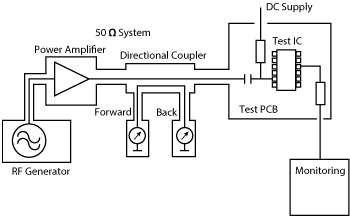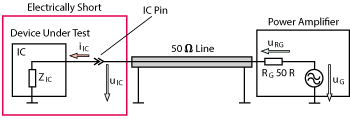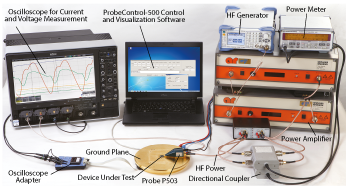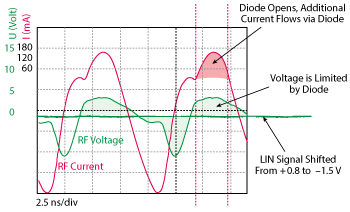Special test procedures are needed to determine the immunity of integrated circuits (IC) to RF interference. Defined RF disturbances must be injected into the IC via defined networks for this purpose. The electromagnetic compatibility (EMC) standard for ICs (IEC 62132) provides three methods for such characterization: the direct power injection (DPI) method, the transverse electromagnetic (TEM) cell method and the use of an IC stripline. The DPI method is based on the conducted injection of disturbance power into the IC. The TEM cell method and the IC stripline are characterized with an electromagnetic field that propagates within a defined cell and acts directly on the IC surface.
This article examines the DPI test method and explains limitations that are used as a starting point to extend this method. The parameters obtained with the extended method describe the IC’s immunity for its future practical use. The IC user can use these immunity parameters as a basis for selecting the appropriate IC for a specific electronic system and as a basis for EMC design in printed circuit board (PCB) development. Furthermore, the IC manufacturer can use this information to narrow and eliminate weak points in the chip. The article also presents a practical example of a local interconnect network (LIN) transceiver that is examined using an extended DPI test method.

Figure 1 DPI method according to IEC 62132-4.
The DPI method according to IEC 62132-4 (see Figure 1) has proven successful in evaluating the EMC immunity of ICs. RF is injected into an individual IC pin by conductive coupling. The RF current flows from a power amplifier to the respective pin via a 50 Ω line and a coupling capacitor. The intensity of the RF disturbance is determined by the forward power that is measured with directional couplers. The power is the correct physical evaluation parameter if an RF-induced rise in temperature in the IC results in its malfunctioning.
Other RF interference events may, however, be independent of the power that is fed in. The oscillator may stop or demodulation may occur in an operational amplifier, a transistor or diode, for example. These interference mechanisms depend only to a small degree on the power converted in the IC; rather, they are triggered directly by basic physical parameters such as the RF current and voltage (e.g., demodulation of the RF current). The disturbance voltage or current is also the parameter responsible for driving the respective interference event in the device under test (DUT) in other fields of EMC testing, such as burst or ESD tests. A high current or a high voltage is not necessarily accompanied by high power.

Figure 2 Setup to measure current and voltage on the pin.
When testing semiconductors, matching depends on the switching state. In addition, the switching edge has to be taken into account with its own mismatch characteristics. The average Pforward, Pback power measurement does not provide relevant system information in terms of the u(t) and i(t) parameters. The variation of the RF current and voltage over time, however, is crucial for gaining new insights, such as the identification of weak points in the IC and for organizing countermeasures in IC and PCB development.

Figure 3 P503 probe.
Measuring Interference With an Ammeter and Voltmeter
The ohmic resistance of a microcontroller power supply pin is usually small, in the range of a milliohm to an ohm. A capacitance of several nF may be integrated into the IC, which also presents impedances on the order of an ohm at frequencies of 100 MHz or higher. IC line inductances produce similar values. Hence, the IC’s internal resistance is very low and may be considerably smaller than the 50 Ω source of the power amplifier. This means that the power amplifier operates under short-circuit conditions, supplying its maximum current. The fed-in current interferes with the IC function, but a power meter shows only a few mW. Consequently, the IC is evaluated as much too weak and is misclassified based on the power evaluation.
The impedances of other IC pins may be between a milliohm and a kilohm. The system approaches short-circuit conditions for IC impedances less than 50 Ω and open-circuit conditions for impedances greater than 50 Ω. Immunity tests at a quasi open-circuit voltage, as are common practice in high voltage technology, are not possible with RF injection into an IC. The current and voltage conditions are system dependent and must be measured directly on the pin (see Figure 2). This electrically short measurement setup avoids metrological difficulties caused by standing waves that may be generated on the line to the power amplifier.
Figures 3 and 4 show the P500 probe measurement system. RF disturbances flow from the power amplifier into the IC pin to be evaluated via the connected P500 probe. An ammeter and voltmeter are integrated into the probe so that the current, voltage and phase angle can be measured directly with an oscilloscope. Power, impedance and other parameters of the device under test are calculated from the measured values. These parameters allow engineers to draw more detailed conclusions about an IC’s EMC within the respective electronic system. Malfunctions that occur at high current intensities, for example, are often due to magnetic coupling, while those that occur at high voltages are due to capacitive coupling. This new RF injection method using integrated current and voltage measurement is beneficial for IC development. It enables the measurement of reactive currents that remain undetected with usual power measurements and provides detailed physical insights that are not otherwise attainable.

Figure 4 Measurement setup with a P503 probe.
Investigating a LIN Transceiver
An RF equivalent circuit can be derived for each IC pin from the results obtained with the P500 probe measurement system. The impedance of the pin depends not only on the switching state of the signal but also on the RF generator voltage. The P500 probe is used to inject a small RF level into the pin. These disturbances must be low enough to prevent protection diodes from opening and additional current paths and elements from becoming effective. On the basis of the u, i and φ values measured with the oscilloscope, the IC’s resistance and reactance is determined as a function of frequency. If there is no dominant capacitive or inductive component, the reactance can be split into XC and XL by calculation. This requires measurements at different frequencies. Weak points can be found in the IC through a high frequency and low frequency current and voltage analysis on the IC pin. The high frequency voltage may cause diode paths to open, for example, resulting in an impedance change.
The measurement system can be used for a variety of practical analyses. For example, it allows the visualization of time-varying, non-sinusoidal high frequency current and voltage waveforms (see Figure 5). Additional current paths will open as soon as the forward voltage of internal diodes is reached. The impedance of the IC drops, the current increases, and the voltage may be limited (feedback to supply network). When a diode opens, new coupling paths become effective; the current that flows through the diode enters other network sections as rectified current. These currents or voltages are superimposed onto useful signals such as trigger or control signals on the LIN driver and cause the FET to go into a blocked, open or undefined state. Further internal IC mechanisms may be clarified by analyzing current and voltage as a function of time. Manufacturers can launch a targeted IC improvement and users can derive EMC countermeasures addressing the IC’s practical use.

Figure 5 Time-varying, non-sinusoidal, high frequency current and voltage waveforms measured with the probe.
Use With Module Development
A sensitive IC can fall victim to interference if an RF current couples to susceptible pins via internal coupling paths in the layout. RF current may flow from a vehicle board network plug to the Vbat pin of the LIN transceiver via corresponding line connections. The RF current may also reach the ground pin via the ground system, particularly in the segmented ground of a two-layer PCB. This coupling path can be blocked by an all-over contact ground system. In addition, the blocking capacitors have to be adequately dimensioned on Vbat. A filter structure that comprises an inductor and two filter capacitors in a pi network is recommended. The filter prevents RF current from reaching the sensitive pin. This measure can be taken with due care at the beginning of development if the Vbat pin is known to be sensitive.
Interference suppression on a module that comprises LIN transceivers is difficult in practice, as the respective pins responsible for IC interference must be identified. The situation becomes unclear if the IC has several sensitive pins that all contribute to its malfunction. The effectiveness of individual measures is concealed due to coupling to other pins. If the IC’s sensitive pins are known, reliable countermeasures may be taken in the right places even before beginning the actual EMC work. EMC problems of ICs can thus be controlled more quickly and easily.
